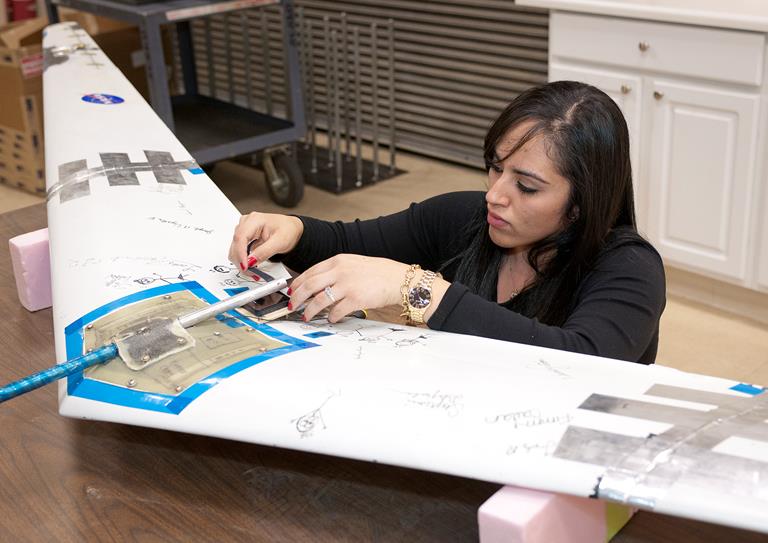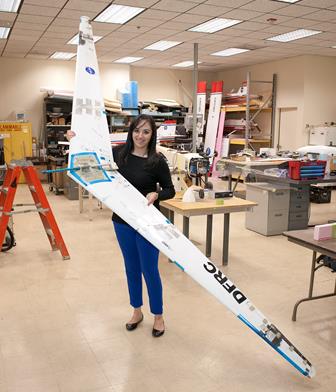
EDWARDS – Nancy Piñón of Rosamond, an undergraduate student at Tuskegee University in Alabama, is working at NASA’s Dryden Flight Research Center during her second summer internship with the center’s Aeronautics Academy.
During a 10-week internship that began in June, Piñón has been working with a team of graduate and undergraduate interns conducting flight tests and gathering data on a scale-model flying wing, the Prandtl-D, which she helped construct during her first internship.
“Last summer, I was working on Prandtl-D,” Piñón said. “Our team started from the ground up, and now we’re actually flying. Over the next few weeks we’ll be working on gathering data and proving that proverse yaw can be identified.”
Adverse yaw, present in current aircraft design, is the horizontal movement around a vertical axis of an aircraft in the direction opposite a turn. As an aircraft banks, differential drag and the slight change in velocity of the left and right wings contributes to aircraft inefficiency. Proverse yaw — yawing in the same direction as a turn — would optimize aircraft performance.

Piñón, a mechanical engineer intern, is working with her mentors, NASA engineers Al Bowers and Oscar Murillo, to collect and analyze the data from the aircraft’s test flights.
“For a flight run, we load up the truck with the Prandtl-D and go to the Muroc Model Masters” model airplane flying site on Rosamond Dry Lake, said Piñón. “The plane is launched with a bungee-cord start. We pull a bungee cable back, connect it onto the PRANDTL-D and let it go.”
For Piñón, seeing Prandtl-D fly for the first time was the best feeling in the world. Currently, she is working on installing a mount on the Prandtl-D that will allow the aircraft to carry an I-phone to record information and flight data for the team. She will also be writing technical reviews of the aircraft’s performance.
Piñón’s childhood heavily influenced her decision to become a mechanical engineer. She is grateful to her family for supporting her career aspirations and encouraging her to strive for excellence.
“I was raised working with my grandpa,” Piñón said. “He’d be out working on cars, and I’d be out working with him. It was very hands-on, and I thought this would be the perfect major for me. So far it’s been great.”
The Aeronautics Academy internship is helping Piñón to cultivate important technical expertise, which will help her achieve her goal of becoming an officer on a nuclear submarine. Piñón, who will be the student commanding officer in her university’s Naval ROTC program this fall, also participates in summer training sessions on submarines to experience Navy life and improve her qualifications.
Piñón feels she is gaining invaluable practice in professionalism and mechanical engineering from her NASA internship. She appreciates the welcoming environment at NASA Dryden and is looking forward to working with her new teammates.
“Working for NASA is a great opportunity,” Piñón said. “I know this summer is going to be great, and I’m really excited.”
For more about NASA Dryden Flight Research Center, visit http://www.nasa.gov/centers/dryden.
(Information via press release from NASA Dryden Flight Research Center.)